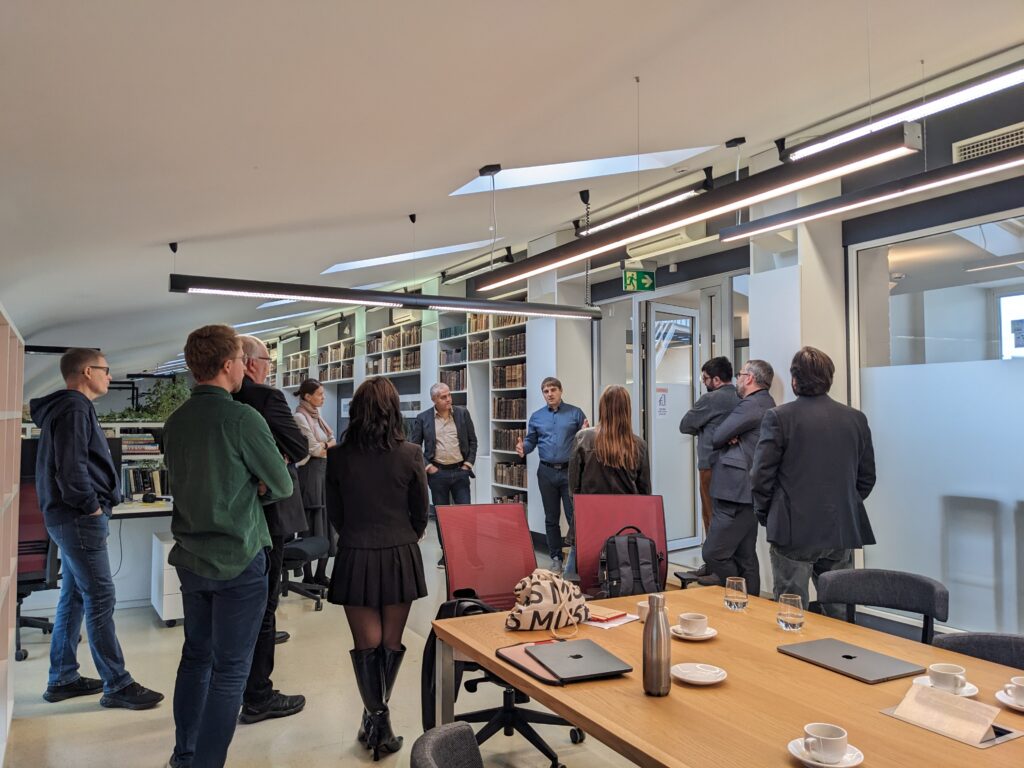 News
News
DIGHT-Net project’s kick-off on 10–11 October 2024 in Tallinn University
October 28, 2024

On October 10–11, 2024, at Tallinn University (TLU), we officially launched the DIGHT-Net project with a two-day kick-off event. The event was attended by professors, archivists, lecturers and PhD candidates and others from TLU and its partner universities, the University of Bologna (UNIBO), the University of Amsterdam (UvA) and the University of Turku (UTU).
After being welcomed by the project leader Prof. Marek Tamm (TLU), who reflected on the project’s very first beginnings back in 2018 and officially launched the DIGHT-Net website, the first day of the kick-off provided an overview of the project’s tasks, goals and deliverables. After the welcoming remarks, European Commission Project Officer David Monteiro elaborated on requirements and recommendations for the project, ranging from project management to communication and dissemination. Building on these insights, the six respective Work Package leaders consequently introduced their main aims and activities.
Starting off was Prof. Daniele Monticelli (TLU) who stressed the importance of the DIGHT-Net partners’ different expertise and networks in contributing to the theoretical framework and methodology for the DIGHT-Hub and other research outputs. Moreover, he posed several crucial reflections concerning the epistemic, theoretical, and transmissible foundations of the project. Thereafter, Dr. Merit Maran, director of the Juri Lotman Semiotics Repository, introduced the repository’s function of retaining Juri Lotman and Zara Mints’s work. Merit moreover elaborated on the steps towards digitising these collections, and how, through developing a semiotic theory of digital cultural heritage, Lotman’s and Umberto Eco’s archives will be twinned.
Next, Prof. Ihab Saloul (UvA) elaborated on the development of excellence in research and teaching, specifically amongst early-career researchers. These tasks not only aim to bridge academic theory with academic knowledge, but to also translate it into practice. Consequently, Prof. Francesco Mazzuchelli (UNIBO) stressed DIGHT-Net’s potential as a network of dialogical knowledge transmission. He highlighted how UNIBO will strengthen research and development practices, increase the success rate of project proposals, and contribute to the digitisation and twinning of Eco’s and Lotman’s archives.
Wrapping up the discussion of the Work Packages, Prof. Hannu Salmi (UTU) introduced his plans for the communication, dissemination, and exploitation of the DIGHT-Net project. Lastly, Marek closed the kick-off’s first day by commenting on the final Work Package on project management, whereafter the discussions were continued during a group dinner in Tallinn’s Rotermanni Quarter.
The following day, the kick-off commenced at Tallinn University’s Academic Library. The program began with an inspiring keynote by Indrek Ibrus, Professor of Media Innovation at TLU and member of DIGHT-Net’s Academic Advisory Board, who spoke about the role of knowledge graphs in studying and making culture. Underlying his lecture where questions of how cultural institutions and their production of audiovisual materials dynamically generate public value through their shaping of cultural memory and steering of political economy. Moreover, Indrek argued, by creating knowledge graphs based on this data, the graphs can be studied as mini-semiospheres, thereby elucidating the dynamic value relations between institutions and societies at specific times.
Next on the program was a guided tour of the TLU’s Centre for Digitisation, where the project members had the chance to see the machines that will also be used for the digitisation of Lotman and Mint’s archives, and to ask questions about the digitisation process.
Then, the afternoon hosted a panel of four junior researchers engaging with topics related to DIGHT-Net project in their PhD research. First, Martina Grinello (UNIBO) presented on the paradox of digitising objects for decolonial means. While digitisation means the production of a new object that can facilitate inclusive history-writing, this new object’s preservation by oftentimes western institutions risks turning into digital colonialism. Secondly, Mark Mets (TLU), introduced how spatial cultural data analysis can enable the bridging of Lotman’s theories and computational methods. Drawing on historical material, Mark demonstrated his attempts to reconstruct a dynamic and latent semiosphere through network relations and embeddings. Thereafter, Marjolein Uittenbogaard (TLU/UvA) presented a preliminary inquiry into the digital museum Srebrenica360. By comparing its digital storytelling with the material Srebrenica Memorial Centre, she discussed the narratives, agendas, and aesthetics of the two sites and their diverging memory effects. Lastly, Yan Asadchy (TLU) elaborated on stereotypical gendered portrayals in AI-generated images. Drawing on a database of approximately 14 million generated images, he found that women are often seen as necessary to understand more individually, while men’s portrayal is more steered by assumptions.
To close the second day of the kick-off, the DIGHT-Net project’s aims and activities were addressed in a group discussion, after which the day was concluded with a shared dinner.
Marjolein Uittenbogaard
